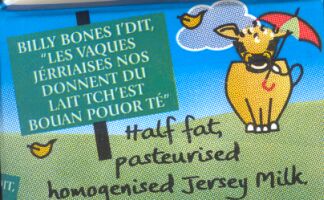

2001 is l'Année d'la Vaque Jèrriaise (Year of the Jersey), so let's look at some relevant words and phrases. First of all, we have eune vaque (a cow) et un touauthé (and a bull). A calf is un vieau, and a heifer is eune g'niche.
One of the pleasures of the Jersey countryside is to see un troupé (a herd) in un clios (a field). Standing there, we can admire les cônes (the horns), lé mûsé (the muzzle), la coue (the tail), les chabots (the hooves) and lé piéchot (the udder). The colour of a typical Jersey cow is so distinctive that if you want to refer to a yellowish-brown, you can say couleu d'vaque (cow-colour).
Les vaques nos donnent du lait (cows give us milk) but la traite (milking) is no longer done in les clios with eune canne à traithe (a milking can) and eune scabelle à traithe (a milking stool). L'agritchultuthe a 'té modèrnisée ach'teu (Agriculture has been modernised now).
In la lait'tie (the dairy) we produce lé beurre (butter), la crème (cream) and also possibly lé fronmage (cheese).
As is to be expected, Jersey people have used cows in ditons. In English, something is like looking for a needle in a haystack, but in Jèrriais i' né f'thait pon bouôn à chèrchi néthe vaque dans geon brûlé (it wouldn't do any good looking for a black cow in burnt gorse). If something is neither one thing nor the other, ch'n'est ni vaque ni vieau (it's neither cow nor calf).
And finally, if you want to be rude about someone who is short, you could say: i' craît en bas coumme la coue d'eune vaque (he grows downwards like a cow's tail)!

Viyiz étout: